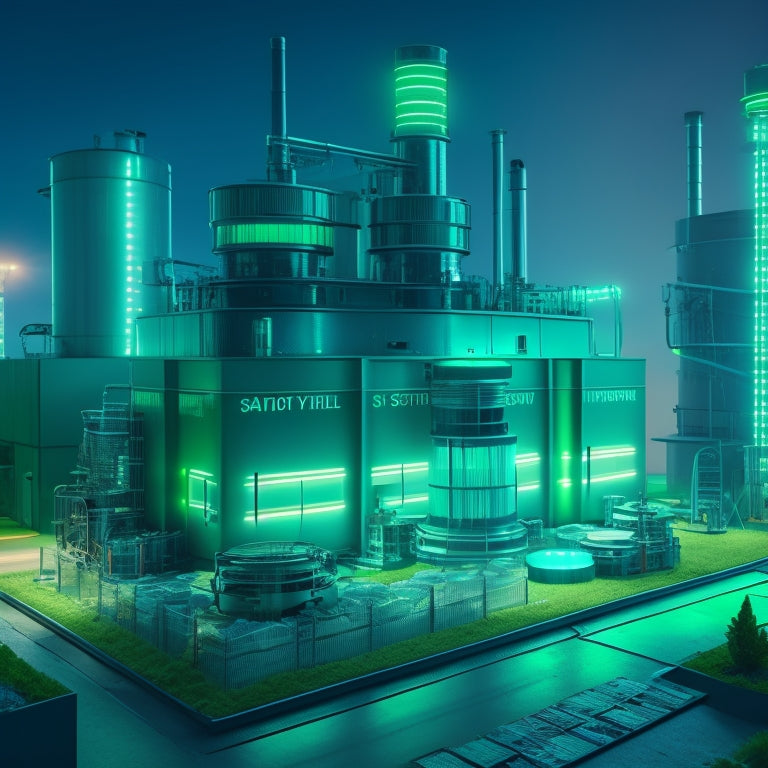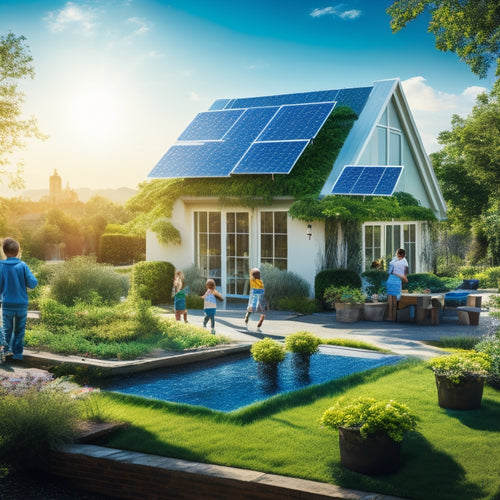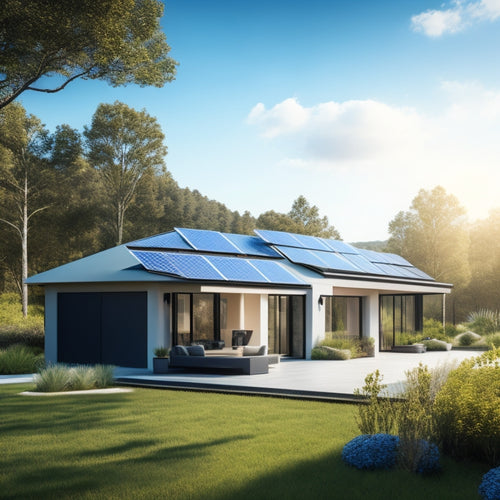
10 Best Ways to Cut Business Energy Expenses
Share
You can substantially reduce business energy expenses by implementing a combination of energy-efficient technologies and practices. Start by switching to energy-efficient lighting, optimizing HVAC system performance, and conducting regular energy audits to identify areas of waste. Implementing smart building technologies, leveraging cost savings from solar panels, and improving insulation and weatherizing can also help. Additionally, consider installing LED lighting solutions, reducing peak demand charges, and investing in energy storage systems. By taking a holistic approach, you can decrease energy consumption, lower expenses, and increase profitability. Now, let's take a closer look at each of these strategies to maximize your energy cost savings.
Key Takeaways
• Replace incandescent bulbs with LEDs or CFLs to slash lighting costs by up to 75%.
• Implement regular HVAC maintenance to reduce energy consumption and extend system lifespan.
• Invest in energy-efficient lighting, HVAC system optimization, and smart building technologies to cut energy waste.
• Conduct regular energy audits to identify areas of energy waste and optimize energy consumption.
• Consider investing in solar panels and energy storage systems to reduce reliance on the grid and lower energy expenses.
Switching to Energy-Efficient Lighting
By replacing traditional incandescent bulbs with energy-efficient alternatives like LEDs or CFLs, you can slash your lighting costs by up to 75%. This switch can have a significant impact on your business's energy expenses.
When selecting energy-efficient lighting, look for products with reputable Energy Labels, such as the ENERGY STAR certification. A well-designed Lighting Design can also help maximize energy savings. Consider factors like lumen output, color temperature, and dimming capabilities to create a most efficient lighting plan.
Optimizing HVAC System Performance
You can greatly reduce energy consumption and extend the lifespan of your heating, ventilation, and air conditioning (HVAC) system by regularly inspecting and maintaining it. Regular tune-ups guarantee that your system operates at peak efficiency, reducing energy waste and improving air quality.
It's vital to inspect and clean air ducts, replace filters, and check for refrigerant leaks. Additionally, system balancing is important to make sure that your HVAC system is distributing air evenly throughout your facility.
Conducting Regular Energy Audits
When you conduct regular energy audits, you'll uncover areas of energy waste and identify opportunities to optimize your systems.
By pinpointing where energy is being squandered, you can implement efficient systems that reduce your energy consumption and lower your expenses.
Through regular audits, you'll be able to identify areas for improvement and make data-driven decisions to cut your business's energy costs.
Identify Energy Waste
Regular energy audits help pinpoint areas of inefficiency, revealing opportunities to curb energy waste and optimize your business's energy consumption. By conducting regular energy audits, you'll identify energy waste and pinpoint areas for improvement. This process involves energy mapping, which involves tracking your energy usage patterns to identify areas of inefficiency. Utility tracking is also vital, as it helps you monitor your energy consumption and identify opportunities for reduction.
| Energy Waste Indicator | Action Item |
| High energy bills | Conduct energy mapping to identify areas of inefficiency |
| Inefficient lighting | Replace traditional lighting with energy-efficient options |
| Peak energy usage | Implement load management strategies to reduce peak demand |
Implement Efficient Systems
By pinpointing areas of inefficiency, you can now focus on implementing efficient systems to reduce energy waste and optimize your business's energy consumption. Conducting regular energy audits helps identify opportunities to streamline operations and reduce energy costs.
Leverage automation tools to monitor and analyze energy usage in real-time, providing valuable insights to inform your energy management strategy. Data analytics plays an important role in identifying trends and patterns, enabling you to make data-driven decisions to optimize energy consumption.
Implementing Smart Building Technologies
You can greatly reduce energy waste and optimize your building's performance by integrating smart building technologies that automate and optimize energy usage. By implementing building automation systems, you can streamline energy consumption and identify areas of inefficiency.
Data analytics provides valuable insights into your energy usage patterns, allowing you to make informed decisions to reduce waste and optimize energy consumption. With real-time monitoring and control, you can adjust energy usage to match occupancy, time of day, and seasonal needs. This level of precision control enables you to minimize energy waste and maximize cost savings.
Using Cost Savings of Solar Panels
As you optimize your building's energy performance with smart technologies, contemplate harnessing the power of solar panels to further reduce your energy expenses. Not only can solar panels greatly cut your energy costs, but they also offer attractive incentives.
Here are some benefits to ponder:
-
Solar Incentives: Take advantage of federal and state tax credits, which can cover up to 30% of your solar panel installation costs.
-
Renewable Certificates: Sell your excess energy back to the grid and earn revenue through Renewable Certificates.
-
Increased Property Value: Installing solar panels can boost your property's value and appeal to environmentally-conscious tenants.
-
Reduced Carbon Footprint: Contribute to a sustainable future by diminishing your reliance on fossil fuels.
-
Low Maintenance: Solar panels require minimal upkeep, ensuring a hassle-free energy solution.
Upgrading to Energy-Star Appliances
Choosing Energy-Star certified appliances in your business can greatly reduce energy consumption and costs by leveraging advanced technologies and design innovations. By upgrading to Energy-Star appliances, you can enjoy significant savings on your energy bills. Look for the Energy Labels on appliances, which indicate that they meet energy efficiency standards set by the U.S. Environmental Protection Agency.
| Appliance | Energy Efficiency Feature | Manufacturer Incentives |
|---|---|---|
| Refrigerator | High-efficiency compressor | 10% discount on purchase |
| Air Conditioner | Inverter technology | $200 rebate on installation |
| LED Lighting | Energy-efficient LED bulbs | Free installation with purchase |
| Water Heater | Insulation and heat traps | $500 rebate on purchase |
| HVAC System | High-efficiency fan motor | 5% discount on maintenance |
Improving Insulation and Weatherizing
Proper insulation and weatherizing can greatly reduce heat loss in the winter and heat gain in the summer, resulting in substantial energy savings for your business. By improving your building's envelope, you can maintain a consistent indoor climate while reducing your energy consumption.
Here are some key areas to focus on:
- Insulate wall cavities to prevent heat transfer
- Seal air leaks around windows, doors, and electrical outlets
- Install weatherstripping around movable joints
- Upgrade to energy-efficient windows
- Guarantee proper insulation in attics, floors, and crawl spaces
Installing LED Lighting Solutions
By optimizing your lighting systems, you can further reduce your business's energy consumption and carbon footprint. Installing LED lighting solutions is a key step in achieving this goal. LED lighting solutions provide significant energy savings, with some LED bulbs using up to 90% less energy than traditional incandescent bulbs.
A well-designed Lighting Design can also enhance the ambiance and productivity of your workspace. Additionally, many LED lighting solutions come with Energy Certifications, such as ENERGY STAR, which can provide tax incentives and rebates.
Reducing Peak Demand Charges
When you're looking to reduce peak demand charges, you'll want to focus on managing your energy usage during peak hours.
You can do this by shifting non-essential loads to off-peak hours, optimizing equipment schedules to minimize energy-intensive activities during peak times, and limiting peak demand hours altogether.
Shift Non-Essential Loads
You can greatly reduce peak demand charges by shifting non-essential loads to off-peak hours, thereby minimizing the maximum power draw from the grid during peak periods. This strategy, known as load shedding, allows you to control your energy consumption and reduce Time of Use (TOU) rates.
By doing so, you can:
- Run non-essential equipment during off-peak hours, such as nighttime or weekends
- Defer non-essential tasks, like data backups or software updates, to off-peak periods
- Use automation to schedule tasks and optimize energy usage
- Implement energy-efficient practices, such as using energy-saving modes on equipment
- Monitor and adjust your energy usage patterns to optimize peak demand reduction
Optimize Equipment Schedules
Optimizing equipment schedules is critical to reducing peak demand charges. It enables you to strategically manage energy-intensive tasks and minimize their impact on your overall energy consumption.
By adjusting production planning, you can identify opportunities to shift energy-intensive tasks to off-peak hours or optimize equipment maintenance schedules to reduce energy usage during peak hours. This approach allows for better management of energy usage and a reduction in peak demand charges.
Analyzing equipment energy usage patterns helps identify opportunities to optimize schedules and reduce energy waste. This proactive approach can lead to a decrease in energy expenses and an improvement in your bottom line.
Limit Peak Demand Hours
By analyzing your energy usage patterns, you can identify the specific hours of the day when your energy consumption peaks, allowing you to take targeted measures to limit peak demand hours and reduce associated charges.
To minimize peak demand charges, consider the following strategies:
-
Time Blocking: Schedule energy-intensive tasks during off-peak hours to reduce peak demand.
-
Shift non-essential loads to off-peak hours using Load Shifting.
-
Implement energy-efficient practices during peak hours, such as turning off unnecessary lights and equipment.
-
Invest in energy-efficient equipment and technologies to reduce overall energy consumption.
- Monitor and adjust your energy usage in real-time to catch potential peak demand hours before they occur.
Investing in Energy Storage Systems
Your business can greatly reduce its reliance on the grid and lower energy expenses by integrating energy storage systems into its operations. By investing in energy storage, you'll have more control over your energy consumption and costs.
A key consideration is battery durability, as it directly impacts the system's overall performance and lifespan. Look for systems with high-quality batteries that can withstand frequent charging and discharging.
Additionally, energy storage systems can enhance grid resiliency by providing backup power during outages. This not only reduces downtime but also protects your business from revenue losses.
Frequently Asked Questions
Can Energy-Efficient Practices Negatively Impact Employee Productivity?
When you're "burning the midnight oil," you wonder if energy-efficient practices might dim employee productivity. However, research suggests that eco-friendly workplaces can boost Workplace Morale, fostering positive Office Dynamics, which in turn, can increase productivity and job satisfaction.
Are Energy-Efficient Solutions Expensive to Implement Initially?
When considering energy-efficient solutions, you'll need to weigh the initial investment against the potential long-term savings. Conduct a thorough cost-benefit analysis to determine if the upfront costs will yield significant returns and justify the expense.
How Long Does It Take to See ROI on Energy-Efficient Investments?
"Imagine sailing through a sea of uncertainty, searching for a beacon of return on investment. You'll find it with payback analysis, which reveals the treasure of energy-efficient investments within 2-5 years, depending on investment cycles, ensuring a smooth voyage to cost savings."
Can Energy-Efficient Practices Be Applied to Older Buildings?
When retrofitting older buildings, you'll face unique challenges, such as preserving historical integrity while implementing energy-efficient upgrades, requiring careful planning to balance retrofitting challenges with historical preservation goals.
Do Energy-Efficient Solutions Require Frequent Maintenance?
"Ha! You think energy-efficient solutions require constant babysitting? Not quite. With well-planned Maintenance Schedules and a pinch of Technical Expertise, you'll be enjoying those cost savings without frequent hand-holding."
Related Posts
-

Solar Energy Benefits for Sustainable Living
Solar energy provides numerous benefits for sustainable living that you can't overlook. By switching to solar, you'll...
-

Long-Term Cost Savings With Solar Panels
Investing in solar panels offers substantial long-term savings on energy costs. You'll benefit from federal tax credi...
-

Eco-Friendly Energy Storage Systems for Houses
Eco-friendly energy storage systems for your house let you capture and use renewable energy efficiently. You can choo...


